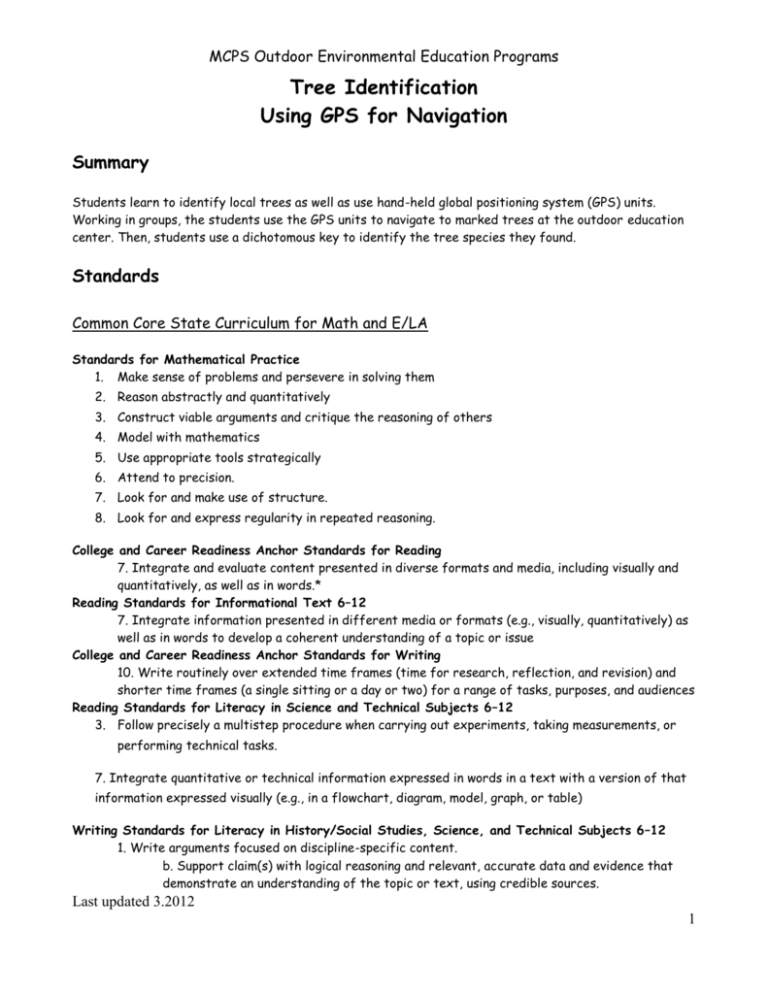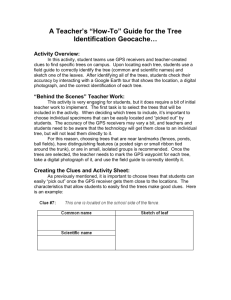Tree Identification Using GPS for Navigation Lesson Plan
advertisement

MCPS Outdoor Environmental Education Programs Tree Identification Using GPS for Navigation Summary Students learn to identify local trees as well as use hand-held global positioning system (GPS) units. Working in groups, the students use the GPS units to navigate to marked trees at the outdoor education center. Then, students use a dichotomous key to identify the tree species they found. Standards Common Core State Curriculum for Math and E/LA Standards for Mathematical Practice 1. Make sense of problems and persevere in solving them 2. Reason abstractly and quantitatively 3. Construct viable arguments and critique the reasoning of others 4. Model with mathematics 5. Use appropriate tools strategically 6. Attend to precision. 7. Look for and make use of structure. 8. Look for and express regularity in repeated reasoning. College and Career Readiness Anchor Standards for Reading 7. Integrate and evaluate content presented in diverse formats and media, including visually and quantitatively, as well as in words.* Reading Standards for Informational Text 6–12 7. Integrate information presented in different media or formats (e.g., visually, quantitatively) as well as in words to develop a coherent understanding of a topic or issue College and Career Readiness Anchor Standards for Writing 10. Write routinely over extended time frames (time for research, reflection, and revision) and shorter time frames (a single sitting or a day or two) for a range of tasks, purposes, and audiences Reading Standards for Literacy in Science and Technical Subjects 6–12 3. Follow precisely a multistep procedure when carrying out experiments, taking measurements, or performing technical tasks. 7. Integrate quantitative or technical information expressed in words in a text with a version of that information expressed visually (e.g., in a flowchart, diagram, model, graph, or table) Writing Standards for Literacy in History/Social Studies, Science, and Technical Subjects 6–12 1. Write arguments focused on discipline-specific content. b. Support claim(s) with logical reasoning and relevant, accurate data and evidence that demonstrate an understanding of the topic or text, using credible sources. Last updated 3.2012 1 MCPS Outdoor Environmental Education Programs Science State Curriculum 1.A.1 design, analyze, or carry out simple investigations and formulate appropriate conclusions based on data obtained or provided 1.A.1.g give reasons for the importance of waiting until an investigation has been repeated many times before accepting the results as correct 1.B.1.d describe the reasoning that led to the interpretation of data and conclusions drawn Mastery Objectives By the end of this lesson, students will be able to 1. Use a dichotomous key to identify trees. 2. Use GPS technology to find destinations and to return home. Engage Activator: Ask the students Why are trees important in an ecosystem? Name some trees found in Maryland What features of trees can we use to identify them? What tools can we use to identify trees? Tree ID and Dichotomous Keys Show the students how to use a dichotomous key: A dichotomous key consists of paired descriptions. Starting with the first pair, choose the most appropriate statement. Go to the next pair of descriptions as indicated by your choice. Continue this until you reach a conclusion as to the identity of the tree. Using GPS Units Background • At least 24 GPS satellites transmit location and time data at all times • GPS units must receive signals from at least 3 satellites to determine location, 4 to determine elevation • The units are accurate to about 10 meters • Show the students the parts of the GPS – buttons along the side, antenna, etc. Last updated 3.2012 2 MCPS Outdoor Environmental Education Programs Getting Started: Press and hold the POWER button. It will try to locate satellites. Press ENTER to say we are indoors. In order to receive the satellite signals, you must be OUTSIDE with a clear view of the sky. There are 5 main pages. The PAGE button lets you move from page to page. Finding a Waypoint – the student worksheets review these steps also. 1. Press PAGE until you see the menu page. 2. Press UP or DOWN to highlight waypoints and press ENTER. 3. Press UP or DOWN and highlight the Q-T tab and press ENTER. 4. Press DOWN until you find a waypoint called TRSC01 (Tree ID at Smith Center #1) and press ENTER. 5. On the review waypoint page press UP or DOWN until Go To is highlighted and press ENTER. 6. The Compass page will appear. 7. To find the location, walk in the direction of the arrow. You must be moving for the arrow to point in the correct location. 8. You will need to adjust your line of travel to avoid obstacles and to stay on the trails. 9. The GPS is only accurate to 10 meters, so when you are close, split up and look all around to find the tree with the marker. Identify the Tree As a team, use the tree identification materials to determine what species of tree it is. Record your answer on the data sheet. Follow the same steps to locate the next tree/waypoint. Other Helpful Pages When you’re outside, the SkyView page must say “Ready to Navigate” before you can begin. The Trip Computer page tells the time so you know when to return. Safety Reminders • Do not cross streams or roads (except Meadowside Lane) • Stay on the trails • Stay together – do not leave your group • No running • Return on time • Respect the park Before they leave Designate a time to return – at least 15 minutes before the end of class. Record the names of the students in each group and which tree numbers they’ve been assigned. Check that each group has a time keeping device. Last updated 3.2012 3 MCPS Outdoor Environmental Education Programs Explore Send the students out to find and identify the trees! Send chaperones with groups if possible. Explain When all groups have returned, review the data they’ve collected – names of trees and helpful features. Ask the students to share what they found easy and what they found challenging about this assignment. Extend 1. Give students DBH (Diameter at Breast Height) tapes to measure trees 2. Ask students to collect other data about the trees or make observations as they travel. Evaluate Answer reflection questions (in journal if applicable): Sketch three of the trees you identified and label important distinguishing features that helped you and your group identify them. Last updated 3.2012 4










